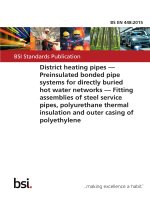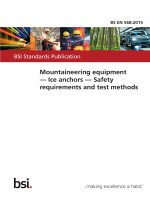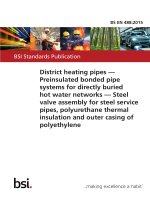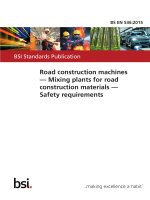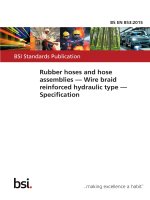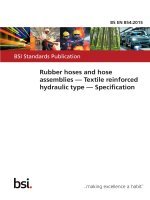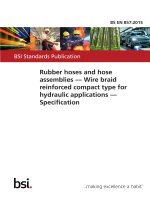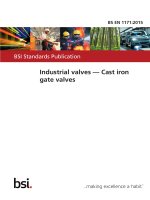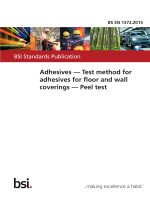BS EN 124-1 2015 Gully tops and manhole tops for vehicular and pedestrian areas
Bạn đang xem bản rút gọn của tài liệu. Xem và tải ngay bản đầy đủ của tài liệu tại đây (1.4 MB, 50 trang )
BS EN 124-1:2015
BSI Standards Publication
Gully tops and manhole
tops for vehicular and
pedestrian areas
Part 1: Definitions, classification,
generalprinciples of design,
performance requirements and test
methods
BS EN 124-1:2015
BRITISH STANDARD
National foreword
This British Standard is the UK implementation of EN 124-1:2015.
Together with BS EN 124-2:2015, BS EN 124-3:2015, BS EN 124-4:2015,
BS EN 124-5:2015 and BS EN 124-6:2015, it supersedes BS EN 124:1994
which is withdrawn.
BSI, as a member of CEN, is obliged to publish EN 124-1 as a British
Standard. However, attention is drawn to the fact that during the
development of this European Standard, the UK committee voted
against its approval as a European Standard.
The technical reasoning behind the response relates to three specific
areas:
1. Subclause 7.4.2 specifies three alternative sets of requirements to
provide adequate skid resistance. The UK committee expresses concern
that there is no research available to validate the equivalence or
adequacy of these requirements.
2. The pull-out tests as described in Annex E are not representative of
in-service conditions and are not supported by any evidence of safe
behaviour in service, taking no account of the forces that may generate
cover movement and/or displacement. Consequently the requirements
of subclause 6.6 and the test method in Annex E may not guarantee
or provide guidance to users and specifiers for the durability and safe
behaviour of manhole tops and gully tops in service.
3. The load tests described in subclause A.4.2 do not take into account
the load bearing capacity of individual or multiple cover elements at test
locations other than the prescribed centralized test locations and the
subsequent effects on performance and durability of the installation.
Readers of this standard may find it useful to refer to BS 7903, Guide to
selection and use of gully tops and manhole covers for installation within
the highway.
Users may wish to consider these issues when specifying products.
The UK participation in its preparation was entrusted by Technical
Committee B/505, Wastewater engineering, to Subcommittee B/505/4,
“Manhole Covers, Surface Boxes And Other Road Fittings”.
A list of organizations represented on this subcommittee can be
obtained on request to its secretary.
This publication does not purport to include all the necessary provisions
of a contract. Users are responsible for its correct application.
© The British Standards Institution 2015.
Published by BSI Standards Limited 2015
ISBN 978 0 580 79318 9
ICS 93.080.30
Compliance with a British Standard cannot confer immunity from
legal obligations.
This British Standard was published under the authority of the Standards
Policy and Strategy Committee on 31 July 2015.
Amendments/corrigenda issued since publication
Date
Text affected
EN 124-1
EUROPEAN STANDARD
NORME EUROPÉENNE
EUROPÄISCHE NORM
June 2015
ICS 93.080.30
Supersedes EN 124:1994
English Version
Gully tops and manhole tops for vehicular and pedestrian areas Part 1: Definitions, classification, general principles of design,
performance requirements and test methods
Dispositifs de couronnement et de fermeture pour les zones
de circulation utilisées par les piétons et les véhicules Partie 1 : Définitions, classification, principes généraux de
conception, exigences de performances et méthodes
d'essai
Aufsätze und Abdeckungen für Verkehrsflächen - Teil 1:
Definitionen, Klassifizierung, allgemeine Baugrundsätze,
Leistungsanforderungen und Prüfverfahren
This European Standard was approved by CEN on 12 March 2015.
CEN members are bound to comply with the CEN/CENELEC Internal Regulations which stipulate the conditions for giving this European
Standard the status of a national standard without any alteration. Up-to-date lists and bibliographical references concerning such national
standards may be obtained on application to the CEN-CENELEC Management Centre or to any CEN member.
This European Standard exists in three official versions (English, French, German). A version in any other language made by translation
under the responsibility of a CEN member into its own language and notified to the CEN-CENELEC Management Centre has the same
status as the official versions.
CEN members are the national standards bodies of Austria, Belgium, Bulgaria, Croatia, Cyprus, Czech Republic, Denmark, Estonia,
Finland, Former Yugoslav Republic of Macedonia, France, Germany, Greece, Hungary, Iceland, Ireland, Italy, Latvia, Lithuania,
Luxembourg, Malta, Netherlands, Norway, Poland, Portugal, Romania, Slovakia, Slovenia, Spain, Sweden, Switzerland, Turkey and United
Kingdom.
EUROPEAN COMMITTEE FOR STANDARDIZATION
COMITÉ EUROPÉEN DE NORMALISATION
EUROPÄISCHES KOMITEE FÜR NORMUNG
CEN-CENELEC Management Centre: Avenue Marnix 17, B-1000 Brussels
© 2015 CEN
All rights of exploitation in any form and by any means reserved
worldwide for CEN national Members.
Ref. No. EN 124-1:2015 E
BS EN 124-1:2015
EN 124-1:2015 (E)
Contents
Page
Foreword ..............................................................................................................................................................4
1
Scope ......................................................................................................................................................6
2
Normative references ............................................................................................................................6
3
3.1
3.2
Terms and definitions, symbols, units and abbreviated terms ........................................................7
Terms and definitions ...........................................................................................................................7
Symbols and abbreviated terms ....................................................................................................... 11
4
4.1
4.2
Classification....................................................................................................................................... 11
Basis of the classification .................................................................................................................. 11
Classification in the context of intended use .................................................................................. 11
5
5.1
5.2
5.3
Materials .............................................................................................................................................. 13
General ................................................................................................................................................. 13
Cover fillings ....................................................................................................................................... 13
Frames in combination with concrete .............................................................................................. 13
6
6.1
6.2
6.3
6.4
6.5
6.6
6.7
6.8
6.9
6.10
6.11
6.12
6.13
6.14
6.15
6.16
6.17
6.18
Design requirements .......................................................................................................................... 13
Vents in covers ................................................................................................................................... 13
Clear opening of manhole tops for man entry ................................................................................. 14
Depth of insertion ............................................................................................................................... 14
Clearance ............................................................................................................................................. 14
Compatibility of seatings ................................................................................................................... 15
Securing of the cover/grating within the frame ............................................................................... 15
Handling of covers and gratings ....................................................................................................... 16
Slot dimensions of gratings .............................................................................................................. 16
Dirt pans and dirt buckets ................................................................................................................. 17
Positioning of covers and gratings................................................................................................... 18
Flatness of manhole covers and gratings ........................................................................................ 18
Concaveness of gratings ................................................................................................................... 18
Surface conditions.............................................................................................................................. 18
Manhole tops with sealing features .................................................................................................. 18
Frame bearing area ............................................................................................................................. 18
Frame depth ........................................................................................................................................ 18
Opening angle of hinged covers/gratings ........................................................................................ 19
Covers with fillings ............................................................................................................................. 19
7
7.1
7.2
7.3
7.4
7.5
Performance requirements ................................................................................................................ 19
Appearance ......................................................................................................................................... 19
Load bearing capacity ........................................................................................................................ 19
Permanent set ..................................................................................................................................... 19
Skid resistance.................................................................................................................................... 20
Child safety.......................................................................................................................................... 21
8
8.1
8.2
8.3
8.4
8.5
Testing ................................................................................................................................................. 22
General ................................................................................................................................................. 22
Permanent set (see 7.3) ...................................................................................................................... 22
Load bearing capacity (see 7.2) ........................................................................................................ 22
Verification of design requirements ................................................................................................. 22
Child safety.......................................................................................................................................... 24
9
Assessment and verification of constancy of performance (AVCP) ............................................. 24
2
BS EN 124-1:2015
EN 124-1:2015 (E)
Annex A (normative) Permanent set test ....................................................................................................... 25
A.1
Test Samples ....................................................................................................................................... 25
A.2
Permanent set test load, (FP).............................................................................................................. 25
A.3
Apparatus ............................................................................................................................................. 25
A.4
Procedure ............................................................................................................................................. 26
Annex B (normative) Test of load bearing capacity ...................................................................................... 29
B.1
Test samples ........................................................................................................................................ 29
B.2
Test load (FT) ........................................................................................................................................ 29
B.3
Test procedure ..................................................................................................................................... 29
B.4
Test report ............................................................................................................................................ 29
Annex C (normative) Test to determine the unpolished skid resistance value (USRV) of manhole
covers ................................................................................................................................................... 30
C.1
General ................................................................................................................................................. 30
C.2
Apparatus ............................................................................................................................................. 30
C.3
Calibration of pendulum friction test equipment ............................................................................. 30
C.4
Selection of test samples ................................................................................................................... 30
C.5
Test procedure ..................................................................................................................................... 30
Annex D (normative) Tilt test ........................................................................................................................... 33
D.1
General ................................................................................................................................................. 33
D.2
Test procedure ..................................................................................................................................... 33
Annex E (normative) Testing of securing of covers/gratings within the frame ......................................... 36
E.1
General ................................................................................................................................................. 36
E.2
Vertical pull-out test procedure ......................................................................................................... 37
Annex F (informative) Recommendations for installation ............................................................................ 41
F.1
General ................................................................................................................................................. 41
F.2
Place of installation and selection of appropriate manhole tops and gully tops ......................... 41
F.3
Preparations before installation ........................................................................................................ 41
F.4
Operative skill, training and installation equipment ........................................................................ 41
F.5
Bedding and packing materials ......................................................................................................... 42
F.6
Condition of supporting chamber ..................................................................................................... 42
F.7
Fixing of manhole tops or gully tops ................................................................................................ 42
F.8
Post installation check and cleaning ................................................................................................ 42
Annex G (informative) Explanations on testing of manhole tops with multiple covers and testing
the skid resistance .............................................................................................................................. 44
G.1
Explanation to A.4 ............................................................................................................................... 44
G.2
Explanation to 7.4.2 ............................................................................................................................. 44
Bibliography ...................................................................................................................................................... 45
3
BS EN 124-1:2015
EN 124-1:2015 (E)
Foreword
This document (EN 124-1:2015) has been prepared by Technical Committee CEN/TC 165 “Wastewater
engineering”, the secretariat of which is held by DIN.
This European Standard shall be given the status of a national standard, either by publication of an identical
text or by endorsement, at the latest by December 2015 and conflicting national standards shall be withdrawn
at the latest by March 2017.
Attention is drawn to the possibility that some of the elements of this document may be the subject of patent
rights. CEN [and/or CENELEC] shall not be held responsible for identifying any or all such patent rights.
Together with EN 124-2:2015, EN 124-3:2015, EN 124-4:2015, EN 124-5:2015 and EN 124-6:2015, this
document supersedes EN 124:1994.
This document has been prepared under a mandate given to CEN by the European Commission and the
European Free Trade Association.
EN 124, Gully tops and manhole tops for vehicular and pedestrian areas, consists of the following parts:
—
Part 1: Definitions, classification, general principles of design, performance requirements and test
methods;
—
Part 2: Gully tops and manhole tops made of cast iron;
—
Part 3: Gully tops and manhole tops made of steel or aluminium alloys;
—
Part 4: Gully tops and manhole tops made of steel reinforced concrete;
—
Part 5: Gully tops and manhole tops made of composite materials;
—
Part 6: Gully tops and manhole tops made of polypropylene (PP), polyethylene (PE) or unplasticized
poly(vinyl chloride) (PVC-U).
EN 124-1 is not a harmonized standard but a supporting standard for the harmonized standards EN 124-2,
EN 124-3, EN 124-4, EN 124-5 and EN 124-6.
The main changes with respect to the previous edition are listed below:
a)
the standard was split into 6 parts, where Part 1 contains general design and performance requirements
and Parts 2 to 6 performance requirements for manhole tops and gully tops made of specific materials;
b)
definition for “securing feature” added;
c)
definition for “locking accessory” added;
d)
skid resistance test added;
e)
tilt test added;
f)
test of securing of covers/gratings within the frame added;
g)
evaluation of conformity changed to AVCP;
h)
recommendations for installation added.
4
BS EN 124-1:2015
EN 124-1:2015 (E)
According to the CEN-CENELEC Internal Regulations, the national standards organizations of the following
countries are bound to implement this European Standard: Austria, Belgium, Bulgaria, Croatia, Cyprus, Czech
Republic, Denmark, Estonia, Finland, Former Yugoslav Republic of Macedonia, France, Germany, Greece,
Hungary, Iceland, Ireland, Italy, Latvia, Lithuania, Luxembourg, Malta, Netherlands, Norway, Poland, Portugal,
Romania, Slovakia, Slovenia, Spain, Sweden, Switzerland, Turkey and the United Kingdom.
5
BS EN 124-1:2015
EN 124-1:2015 (E)
1
Scope
This European Standard is applicable to manhole tops and gully tops with a clear opening up to and including
1 000 mm for covering gullies, manholes and inspection chambers installed in areas subjected to pedestrian
and/or vehicular traffic. It specifies definitions, classification, general principles of design, performance
requirements and test methods for gully tops and manhole tops according to:
—
EN 124-2, for gully tops and manhole tops made of cast iron;
—
EN 124-3, for gully tops and manhole tops made of steel or aluminium alloys;
—
EN 124-4, for gully tops and manhole tops made of steel reinforced concrete;
—
EN 124-5, for gully tops and manhole tops made of composite materials;
—
EN 124-6, for gully tops and manhole tops made of polypropylene (PP), polyethylene (PE) or
unplasticized poly(vinyl chloride) (PVC-U).
Part 1 is only applicable in combination with at least one of the standards EN 124-2, EN 124-3, EN 124-4,
EN 124-5 and EN 124-6 each of which has this Part 1 as an integral part.
This European Standard is not applicable to:
—
gratings/covers as part of prefabricated drainage channels according to EN 1433,
—
floor and roof gullies in buildings which are specified in EN 1253 (all parts),
—
surface boxes.
2
Normative references
The following documents, in whole or in part, are normatively referenced in this document and are
indispensable for its application. For dated references, only the edition cited applies. For undated references,
the latest edition of the referenced document (including any amendments) applies.
EN 124-2:2015, Gully tops and manhole tops for vehicular and pedestrian areas — Part 2: Gully tops and
manhole tops made of cast iron
EN 124-3:2015, Gully tops and manhole tops for vehicular and pedestrian areas — Part 3: Gully tops and
manhole tops made of steel or aluminium alloys
EN 124-4:2015, Gully tops and manhole tops for vehicular and pedestrian areas — Part 4: Gully tops and
manhole tops made of steel reinforced concrete
EN 124-5:2015, Gully tops and manhole tops for vehicular and pedestrian areas — Part 5: Gully tops and
manhole tops made of composite materials
EN 124-6:2015, Gully tops and manhole tops for vehicular and pedestrian areas — Part 6: Gully tops and
manhole tops made of polypropylene (PP), polyethylene (PE) or unplasticized poly(vinyl chloride) (PVC-U)
EN 206:2013, Concrete — Specification, performance, production and conformity
EN 13036-4, Road and airfield surface characteristics — Test methods — Part 4: Method for measurement of
slip/skid resistance of a surface: The pendulum test
6
BS EN 124-1:2015
EN 124-1:2015 (E)
EN ISO 868, Plastics and ebonite — Determination of indentation hardness by means of a durometer (Shore
hardness) (ISO 868)
EN ISO 7500-1:2004, Metallic materials — Verification of static uniaxial testing machines — Part 1:
Tension/compression testing machines — Verification and calibration of the force-measuring system
(ISO 7500-1:2004)
3
Terms and definitions, symbols, units and abbreviated terms
For the purposes of this document, the following terms and definitions apply.
3.1
Terms and definitions
3.1.1
manhole
structure with a removable cover constructed on a drain or sewer to permit entry by personnel
[SOURCE: EN 16323:2014, 2.2.4.15]
3.1.2
inspection chamber
structure with a removable cover constructed on a drain or sewer that permits the introduction of cleaning and
inspection equipment from surface level, but does not provide access for personnel
[SOURCE: EN 16323:2014, 2.2.4.13]
3.1.3
gully
assembly to receive water for discharge into a drainage system
3.1.4
gully top
upper part of a gully consisting of a frame and grating with or without cover
3.1.5
manhole top
upper part of a manhole or inspection chamber consisting of a frame and cover and/or grating
3.1.6
frame
part of a gully top or manhole top which receives and supports a grating and/or a cover
3.1.7
frame depth
distance between the top surface and the bottom surface of the frame
3.1.8
grating
movable part(s) or opening within a manhole top or a gully top which permit(s) the passage of water through
itself into the gully or manhole
3.1.9
cover
movable part(s) of a manhole top or a gully top which covers the manhole or gully opening
7
BS EN 124-1:2015
EN 124-1:2015 (E)
3.1.10
element
frame or cover or grating of a manhole top or gully top
Note 1 to entry:
Hinges, locking accessories and other accessories are not elements.
3.1.11
vent
opening in the cover of a manhole top to provide ventilation
3.1.12
dirt bucket
removable component of a gully top which collects debris
3.1.13
dirt pan
removable component of manhole top which collects debris
3.1.14
seating
surface on which the grating or the cover rests in the frame
3.1.15
depth of insertion
A
distance between the top of the frame and the bottom of the cover or grating adjacent to the seating
Note 1 to entry:
Examples are given in Figure 1. The depth of insertion is expressed in millimetres (mm).
a) Example 1: A for non-stepped covers/gratings
b) Example 2: A for stepped covers/gratings when b ≤ a
c) Example 3: A for stepped covers/gratings when b > a
Figure 1 — Examples for determination of depth of insertion
3.1.16
total clearance
Σa
sum of the maximum individual clearances between adjacent elements of the frame and grating/cover
Note 1 to entry:
Examples are shown in Figure 2 a), Figure 2 b) and Figure 2 c).
Note 2 to entry:
The total clearance is expressed in millimetres (mm).
8
BS EN 124-1:2015
EN 124-1:2015 (E)
Σa = al + ar
Σa = al + ac1 + ac2 + ar
a) Example 1
Σa = al + ac + ar
b) Example 2
c) Example 3
Key
al
ac
clearance left
ar
clearance centre
clearance right
Figure 2 — Examples for the determination of total clearance
3.1.17
frame bearing area
Ab
surface of the underside of a frame which rests upon the supporting structure
Note 1 to entry:
2
The bearing area is expressed in square millimetres (mm ).
3.1.18
clear opening
CO
diameter of the largest circle that can be inscribed in the clear area (3.1.19) of the frame
Note 1 to entry:
Examples are shown in Figures 3 a) to 3 f).
Note 2 to entry:
The clear opening is expressed in millimetres (mm).
a) Example 1
b) Example 2
c) Example 3
d) Example 4
1 fixed bars
e) Example 5
f) Example 6
Figure 3 — Examples of clear opening
9
BS EN 124-1:2015
EN 124-1:2015 (E)
3.1.19
clear area
CA
unobstructed area between the seatings in the frame
Note 1 to entry:
Examples for unobstructed areas are shown as the shaded area in Figure 4 a) to Figure 4 c). In the
case that the area of seatings in the frame is interrupted by functional areas, for example, areas for drainage of water,
areas for holding dirt pans or means for access to manholes and spaces for hinges, locking and securing systems, these
functional areas are not considered for the calculation of mass per unit area. If there are more possibilities the larger of the
possible clear areas need to be used.
Note 2 to entry:
2
The clear area is expressed in square millimetres (mm ).
a) Example 1
b) Example 2
c) Example 3
Figure 4 — Examples of clear area
3.1.20
waterway area
overall effective drainage inlet area on the top surface of gully tops and in kerb units
Note1 to entry:
2
The waterway area is expressed in square millimetres (mm ).
3.1.21
securing feature
feature which is integral with frame or cover(s)/gratings(s) or installed as part of the manufacturing process to
safely retain cover(s)/gratings(s) in the frame under traffic conditions in the place of installation and to prevent
inappropriate movement of the cover(s)/gratings(s) such as ejection and non-intended lifting
EXAMPLE
Screws, bolts, spring bars, etc.
3.1.22
mass per unit area
total mass of the cover or the grating in kilograms divided by the clear area in square metres
Note 1 to entry:
2
The mass per unit area is expressed in kg/m .
3.1.23
cushioning insert
accessory provided within a frame, grating or cover to achieve stability and quietness in use
3.1.24
test load
FT
load applied to gully tops or manhole tops for testing the load bearing capacity
Note 1 to entry:
10
The test load is expressed in kilonewtons (kN).
BS EN 124-1:2015
EN 124-1:2015 (E)
3.1.25
permanent set load
FP
load applied to gully tops or manhole tops for testing the permanent set (FP = 2/3 FT)
3.1.26
deflection load
FD
load applied to gully tops or manhole tops for testing the deflection under load (FD = 1/3 FT)
3.1.27
pedestrian area
area reserved for pedestrians and only occasionally open to vehicular traffic for delivery, cleaning purposes or
in an emergency
3.1.28
pedestrian street
area where vehicular traffic is prohibited during certain periods (e.g. pedestrian areas during business hours
and vehicular traffic outside these hours)
3.1.29
locking accessory
added component to prevent unauthorised lifting, opening or removal of cover/grating
3.2
Symbols and abbreviated terms
Pb
Frame bearing pressure
USRV
unpolished skid resistance value
4
4.1
Classification
Basis of the classification
Based on the test loads according to Table 4, gully tops or manhole tops shall be classified into one of the
following classes:
A 15, B 125, C 250, D 400, E 600 or F 900.
4.2
Classification in the context of intended use
This clause provides the link of the classification and the place of installation. For different classes of manhole
tops or gully tops provisions in the place of installation shall be taken into account.
The appropriate class of a manhole top or a gully top to be used depends upon the place of installation. The
various places of installation have been divided into groups numbered 1 to 6, as listed below. Figure 5 and
Figure 6 show the location of some of these groups in a highway environment. The minimum class
recommended for use in each group is shown in brackets. The selection of the appropriate class and the
material is the responsibility of the specifier. Where there is any doubt, the stronger class should be selected.
—
Group 1 (at least class A 15): Areas which can only be used by pedestrians and pedal cyclists.
—
Group 2 (at least class B 125): Pedestrian areas and comparable areas, car parks or car parking decks.
—
Group 3 (at least class C 250): For gully tops, installed in the area of kerbside channels of roads
(Figure 5) which, when measured from the kerb edge, extends a maximum of 0,5 m into the carriageway
and a maximum of 0,2 m into the pedestrian area.
11
BS EN 124-1:2015
EN 124-1:2015 (E)
—
Group 4 (at least class D 400): Carriageways of roads (including pedestrian streets), hard shoulders
(Figure 6) and parking areas, for all types of road vehicles.
—
Group 5 (at least class E 600): Areas imposing high wheel loads, e.g. docks, aircraft pavements.
—
Group 6 (class F 900): Areas imposing particularly high wheel loads, e.g. aircraft pavements.
NOTE 1
Compliance of the product with the respective part of EN 124 series does not replace the responsibility of the
user to ensure that the gully top or the manhole top is correctly installed and its elements (frame and grating/cover) have
the necessary performance values.
For concave gratings the places of installation shall be limited to the following places of intended uses:
—
Groups 1, 2 and 3;
—
Group 4, for parking areas only.
Key
1
Group 1
2
Group 2
3
Group 3
4
Group 4
Figure 5 — Typical highway cross-section showing the location of the groups
Key
1
Group 1
4
Group 4
a
carriage way
b
hard shoulder
Figure 6 — Typical detail of a hard shoulder showing the location of the groups
12
BS EN 124-1:2015
EN 124-1:2015 (E)
NOTE 2
5
5.1
Recommendations for installation are given in Annex F.
Materials
General
Materials used for manhole tops and gully tops shall meet the requirements specified in
—
EN 124-2, for gully tops and manhole tops made of cast iron,
—
EN 124-3, for gully tops and manhole tops made of steel or aluminium alloys,
—
EN 124-4, for gully tops and manhole tops made of precast steel reinforced concrete,
—
EN 124-5, for gully tops and manhole tops made of composite materials,
—
EN 124-6, for gully tops and manhole tops made of polypropylene (PP), polyethylene (PE) or
unplasticized poly(vinyl chloride) (PVC-U).
All materials used shall be compatible, e.g. detrimental electro chemical or galvanic corrosion shall be
avoided.
Manhole tops and gully tops resulting of a combination of elements made from different materials as specified
in EN 124-2, EN 124-3, EN 124-4, EN 124-5 or EN 124-6 shall comply with EN 124-1, and elements shall
comply with the relevant requirements of the material related EN 124-2, EN 124-3, EN 124-4, EN 124-5 and
EN 124-6. The class of the combined product shall be restricted to the lower class determined of any
constituent element according to the relevant part of EN 124-2, EN 124-3, EN 124-4, EN 124-5 or EN 124-6
and be marked accordingly.
Manhole tops and gully tops according to this standard shall be at least suitable for use in wet and dry
conditions and a slightly aggressive chemical environment, i.e. normal conditions for domestic sewage and
treated industrial effluent, and for most natural soils and groundwaters. If more severe conditions are
expected, additional requirements for corrosion protection can be necessary.
5.2
Cover fillings
Cover fillings are only applicable to manhole tops in accordance with EN 124-2 or EN 124-3.
In the case of covers placed on the market in filled condition, the filling materials shall comply with the
requirements in accordance with EN 124-2 or EN 124-3.
In case of covers placed on the market in unfilled condition and the filling is applied subsequently, the filling
materials shall have a minimum performance comparable to concrete or the surrounding pavement materials
and shall fulfil the requirements of the appropriate European Standards.
5.3
Frames in combination with concrete
Where the frame is made of a combination of any material according to this standard and concrete, the
concrete shall have a compressive strength of at least C35/45 in accordance with EN 206:2013.
6
6.1
Design requirements
Vents in covers
Covers can be designed with or without vents. For covers with vents the minimum vent area shall conform to
Table 1 and their dimensions shall conform to Table 2.
13
BS EN 124-1:2015
EN 124-1:2015 (E)
Table 1 — Minimum vent area
Clear opening
CO
Minimum vent area
2
cm
≤ 600 mm
5 % of the area of a circle having a diameter equal to the clear opening
> 600 mm
140
Table 2 — Dimensions of vents
Class
6.2
Dimensions of slots
mm
Diameters of holes
mm
Length
Width
A 15 and B 125
≤ 170
18 to 25
18 to 38
C 250 to F 900
≤ 170
18 to 32
30 to 38
Clear opening of manhole tops for man entry
The clear opening of manhole tops shall be declared in the product documentation.
NOTE
In the vast majority of Member States the clear opening is considered to be at least 600 mm for man entry. In
some other Member States larger openings are required.
6.3
Depth of insertion
Gully tops and manhole tops of classes D 400, E 600 and F 900 with the exception of those secured
according to 6.6 a), shall have a depth of insertion A of minimum 50 mm (see 3.1.15).
6.4
Clearance
6.4.1
Total clearance
The clearance between the different elements of gully tops and manhole tops is defined in 3.1.16. This
clearance can lead to horizontal displacement of the cover or grating in its frame. In order to limit this
displacement, the total clearance Σa, shall conform to the following requirements:
a)
b)
for covers or gratings in one or two parts:
1)
clear opening CO ≤ 400 mm: Σa ≤ 7 mm,
2)
clear opening CO > 400 mm: Σa ≤ 9 mm;
for covers or gratings with three or more parts secured in the frame each individual clearance (al, ac, ar)
shall be limited to a maximum of 5 mm;
c)
for covers or gratings with three or more parts not secured in the frame, the total clearance Σa resulting
from the displacement of all parts shall not exceed 15 mm.
6.4.2
Clearance around hinges
Where hinged covers or gratings have a radial profiled edge on the hinged side, it shall be profiled so that the
gauge of 170 mm × 170 mm × 20 mm, as shown in Figure 7, is prevented from entering the gap between the
adjacent frame and the curved edge of the cover or grating by no more than 13 mm.
14
BS EN 124-1:2015
EN 124-1:2015 (E)
The gauge shall be held vertical and its 170 mm edge parallel to the profiled edge. In addition the gap shall
not exceed the maximum slot dimensions in accordance with Table 3. The tolerance of the gauge shall
be ± 0,2 mm with a maximum radius of 1 mm.
Slots between two hinges of covers or gratings shall not exceed the dimensions in accordance with Table 3.
Dimensions in millimetres
Key
1
frame
2
gauge
3
cover or grating
Figure 7 — Gauge
6.5
Compatibility of seatings
Gully tops and manhole tops of all classes shall be such as to ensure the compatibility of their respective
seatings. This shall be assessed by assembling the cover/grating and the frame.
In addition, for classes D 400 to F 900 these seatings shall be designed/manufactured in such a way as to
ensure quietness in use and stable behaviour. This can be achieved by machining of the contact surfaces, or
the use of cushioning inserts, or three-point suspension design or any other appropriate methods. When
tested according to 8.4.5, the cover/grating shall not have an increased change in height above the upper
edge of the frame by more than 0,5 × depth of insertion with a maximum value of 25 mm at any point on the
perimeter.
6.6
Securing of the cover/grating within the frame
The cover/grating shall be secured within its frame to meet the required conditions relevant to the intended
place of installation defined in 4.2.
This shall be achieved by at least one of the following methods (see also Table E.1):
a)
securing feature;
b)
mass per unit area;
c)
other methods.
15
BS EN 124-1:2015
EN 124-1:2015 (E)
These methods shall be designed so as to allow opening of the covers or gratings by means of usual tools,
except in the case where the specifier requests an additional locking system. For securing methods according
to a) and c) the corrosion resistance shall be at least equivalent to the frame or the cover/grating or the
materials in accordance with EN 124-2 or EN 124-3.
The securing of covers/gratings within the frames shall be tested in accordance with 8.4.6. The securing
method and design details shall be declared.
Where required by specific provisions in the place of intended use, the above mentioned methods for securing
of cover(s)/grating(s) shall comply with these provisions.
NOTE
For purposes such as prevention of unauthorized removal, lifting of cover/gratings or vandalism additional
locking accessories can be required by the specifier. The selection of the appropriate locking accessory is in the
responsibility of the specifier. The provision of the appropriate locking accessory is, in this case, not within the
responsibility of the manufacturer.
6.7
Handling of covers and gratings
Provision shall be made for the effective loosening and for the opening of the covers and gratings by means of
usual tools. Additional lifting features and/or devices can be incorporated in the design of manhole tops and/or
gully tops.
NOTE
6.8
6.8.1
The design and performance of these additional features or devices are not covered by this standard.
Slot dimensions of gratings
Waterway area
For all classes the dimensions of slots in gratings shall be selected having regard to the hydraulic capacity
and the slots shall be evenly distributed over clear area. The waterway area shall not be less than 30 % of the
clear area and shall be provided by the manufacturer.
6.8.2
Slot dimensions
The slots in gratings shall have the dimensions stated in Table 3. The dimensions of slots for classes C 250 to
F 900 shall be dependent on the orientation of the longitudinal axis of the slots in relation to the direction of
traffic, in accordance with Table 3 and Figure 8.
NOTE 1
The dimensions of the waterway area and the openings of side entry or kerb gullies are not specified in this
document.
16
BS EN 124-1:2015
EN 124-1:2015 (E)
Key
1
orientation pos. 1
2
orientation pos. 2
3
direction of traffic
Figure 8 — Orientation of slots in gratings
Table 3 — Slot dimensions
Openings
Straight slots
Slots in other
shapes
a
Orientation
according
Figure 8
Class
to
Pos. 1
Pos. 2
and
A 15 and B 125
a
Width
(mm)
Length
(mm)
8 to 18
No limitation
> 18 to 25
≤ 170
Pos. 1
C 250 to F 900
16 to 32
≤ 170
Pos. 2
C 250
16 to 42
No limitation
D 400 to F 900
18 to 42
No limitation
Slots in other shapes shall not exceed a width of 25 mm for classes A 15 and B 125 and
a width of 42 mm for classes C 250 to F 900. They shall be designed in such a way as to
prevent the 170 mm length of the gauge from entering the slot. The gauge shall be held
vertically with its 170 mm edge parallel to the surface of the grating.
In pedestrian areas and/or pedestrian streets, a reduction of the slot width to 5 mm is permitted.
NOTE 2
The minimum width values of this table do not apply for the slots immediately adjacent to the hinged side of
the grating associated with the opening of the grating (see 6.4.2).
6.9
Dirt pans and dirt buckets
Where dirt pans or dirt buckets are specified, they shall be designed to ensure that drainage and ventilation
can continue when the dirt pan or bucket is full.
17
BS EN 124-1:2015
EN 124-1:2015 (E)
6.10 Positioning of covers and gratings
Where the cover or grating has to be in a predetermined position relative to the frame, this shall be ensured by
an appropriate design.
6.11 Flatness of manhole covers and gratings
The upper surface, of gratings and covers of classes D 400 to F 900, which is the surface in contact with
traffic, shall be flat within a tolerance of 1 % of the clear opening with a maximum of 6 mm.
6.12 Concaveness of gratings
Gratings designed with a dished surface exceeding 6 mm are described as concave.
6.13 Surface conditions
When tested in accordance with 8.4.13, the surface conditions shall be in accordance with 7.4.
NOTE
In certain environments such as, but not limited to, legally required studded tyres or legal toxic emissions
limitations, the specifier can request further appropriate tests to be carried out to check if these are fit for purpose at the
place of installation.
6.14 Manhole tops with sealing features
Manhole tops in accordance with this standard can be designed with sealing features to resist against
accidental upward water pressure. In such a case the frame shall be designed to be securely anchored.
Manhole tops according to this standard can also incorporate sealing features to prevent or limit:
—
the escape of odours through the manhole top (non-pressure); or
—
non-pressure surface water ingress (rain water).
The design and performance of the sealing features are not covered by this standard.
6.15 Frame bearing area
The frame bearing area shall be designed in such a way that the bearing pressure Pb on the basis of the test
2
load FT shall not exceed 7,5 N/mm to provide a contribution to stability under working conditions. The bearing
pressure Pb shall be calculated in accordance with Formula (1):
Pb =
FT
Ab
(1)
where
Ab
NOTE
2
is the frame bearing area in mm .
2
Pb is expressed in N/mm .
6.16 Frame depth
The depth of the frame of manhole tops or gully tops of class D 400, E 600 and F 900 shall be at least
100 mm.
For class D 400 the frame depth may be reduced to 75 mm provided that the frame is made either of cast iron
or steel and provides anchoring facilities.
18
